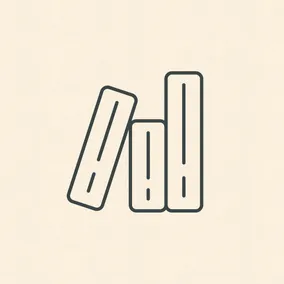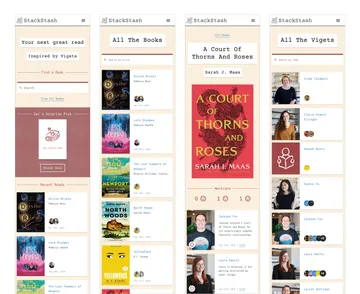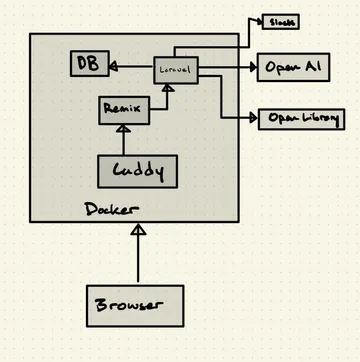StackStash: Taking Bookish Musings to the Next Level

Laura Sweltz, Director of UX Research and Strategic Initiatives,
Chris Manning, Development Director,
Claire Atwell Eisinger, Product Management Director,
Danny Brown, Senior Developer,
David Eisinger, VP of Development,
Emily McDonald, Former Product Manager,
Jackson Fox, VP of UX & Design,
Max Myers, Senior Platform Developer,
Nathan Schmidt, Senior UI Developer, and
Nick Telsan, Senior Developer
Article Categories:
Posted on
Book musings from Viget's #books Slack channel, but make them more useful. That concept inspired our latest Pointless adventure.
We have many book lovers at Viget. Our #books Slack channel has a wealth of information about what books people have read and how they felt about them. While it’s great to have access to that data, Slack doesn’t provide the type of exploratory, visual browsing experience that would be most useful when trying to make decisions about what we might want to read next.
We might wonder:
- Has anyone read Tana French’s The Likeness? How did they feel about it?
- Liz has shared books that I’ve enjoyed in the past. What other titles have they enjoyed?
- What has everyone been reading lately?
During our latest Pointless Palooza, a team of 10 folks at Viget built an app that would help us answer those types of questions in a more engaging way. Rather than digging through a bunch of disparate threads in Slack, we can now use the StackStash app to browse consolidated information. It’s easy to look at a book and see all of the people who have mentioned it (and how they felt about it) or look at a person and see all of the books they’ve mentioned (and how they felt about them).

Behind the Scenes
When we build software for clients, their business needs typically drive decisions around technical architecture, which then informs who works on the project and their role. Pointless Palooza gives us an opportunity to try out new technologies the team is excited about, and flex outside our traditional roles. With a team of six (!) engineers slated to build StackStash together, we needed to decide how to build the application before we got started. This decision was guided by a few high-level goals:
- Get a working end-to-end version of StackStash live on the Internet on Day 1
- Ensure everyone on the technical team could work on something that was interesting to them
- Distribute the workload so that we wouldn’t step on each other’s toes
Much like everything that happens in the software development lifecycle, arriving at our final tech plan was an iterative process. In the days leading up to kickoff, we worked collaboratively to settle on a fun mix of technologies that play to our strengths while also giving us the chance to try some new things:

What We Learned
Bringing this concept to life was not only a fun experience but also provided the team with the chance to learn new skills and technologies. Here are some of the highlights that stood out to us:
Chris
My favorite part of creating StackStash was getting a chance to work with Laravel, which was new to me on this project. I was surprised how easy it was to find most information I was looking for right in the main Laravel documentation. Overall, it was a pleasant experience coming from other popular web frameworks like Rails and Django.
Something I learned was a lot more about Slack API data. There were a lot of little lessons I learned along the way—how message data is generally structured, that `ts` timestamps are kind of IDs, etc.—but the biggest surprise was that the conversation history API we were using didn’t include message replies. You can retrieve replies via a similar endpoint, but as you might imagine, there are a lot more API requests to account for.
Claire
My favorite part of creating StackStash was working with a big team of engineers to divide technical roles and responsibilities. Based on experience from past client projects, we leveraged the “pods” concept, assigning devs in teams of two to larger focus areas. I also enjoyed queuing up work for everyone in a shared gist of our data spec vs. breaking everything out into individual tickets. This was a huge time-saver on the PM side and helped everyone collaborate more easily.
Something I learned was how to write Migrations, Factories, and Database Seeders in Laravel!
Danny
My favorite part of creating StackStash was seeing similarities between Laravel and other web frameworks. Even though the syntax was pretty different, the general ideas for doing things was familiar enough that it was easy to pick up and understand.
Something I learned was the interplay between Typespec, OpenAPI, and TypeScript. I enjoyed learning with those three tools and how they work together in such an enjoyable way.
David
My favorite part of creating StackStash was getting to do some modern PHP. It was the first language I used for web development (in the late 90s 😯) but I haven’t done a great job keeping up on its progress over the last decade. The language, frameworks, and tooling have come a long way. Laravel’s slick, and having a language server to remind me the argument order to `implode` was pretty clutch.
Something I learned was how to write defensive PHP code. I was working on a lot of the API integrations, and I took inspiration from Go to be careful and explicit around failure. Also, a LOT about ISBNs.
Emily
My favorite part of creating StackStash was designing new screens based on the visual language and feature definition that were already established.
Something I learned was how to create animations in Figma!
Jackson
My favorite part of creating StackStash was getting more comfortable using AI platforms like Google’s Gemini and Anthropic’s Claude for data processing. I finally had a good reason to explore tools like Google’s AI Studio to help prototype prompts that became important components in our data pipeline.
Something I learned was that AI tools can do some amazing things — we pulled JSON data out of Slack and had Gemini (and later GPT-4) doing some very impressive data extraction and summarization — but they’re also infuriatingly mysterious at times. Gemini and GPT both excel at fuzzy tasks like summarization and sentiment analysis, but completely fell down on lookup tasks, like gathering ISBNs for books. We eventually switched to GPT-4 because we couldn’t get consistently valid JSON out of Gemini.
Laura
My favorite part of creating StackStash was the opportunity to take bookish joy at Viget to the next level. I hope that StackStash will help my fellow book lovers find a great read the next time they’re on the hunt for a new book.
Something I learned was how to feel more comfortable and confident when using Figma to create high-fidelity designs. As a researcher, I primarily leverage Figma when conducting testing with prototypes. Things like components, variants, and autolayout can feel intimidating to someone who doesn’t typically do in-the-weeds design work. This project gave me an excuse to spend dedicated time learning how to use Figma effectively for design production.
Max
My favorite part of creating StackStash was seeing all the different pieces come together to create something meaningful. Everyone was working on their specific area and seeing it all intersect was really cool.
Something I learned was OpenAPI and TypeSpec. It was a new experience for me to work with OpenAPI to develop a spec for our API and use that to test our API endpoints against. It really helped to make sure everyone was able to be on the same page with the data we expected in both the backend and frontend. I also got to dabble with TypeSpec to generate the OpenAPI spec which was also a learning experience for me. I enjoyed stepping out of PHP and into some new concepts.
Nathan
My favorite part of creating StackStash was exploring all the different AI models that are out there and testing which one would work best for our project.
Something I learned was… Laravel, AI, Remix, and Panda CSS. Worked with Laravel when it first came out (8+ years ago) so there was a lot of brushing up and relearning. Overall really like it and would love to use Laravel again in another project. We went with Gemini AI to start with as it had a really good free tier and it seemed to return what we needed in a JSON format pretty consistently. But as we got more into integrating it into our app data we noticed that Gemini did not return perfect JSON every time. So we decided to change over to OpenAI as we can set it to format the response into valid JSON. Also learned a lot about Remix and Panda CSS as it was my first time working in both. There was a learning curve but having worked with React it was pretty easy to pick up.
Nick
My favorite part of creating StackStash was rapidly building a bunch of UI in a familiar, but not too familiar, framework.
Something I learned was…. Laravel, Remix, more Docker magic, TypeSpec, and more. I spent some time working with animations, which is always both a treat and a slog. Getting everything set up and it mostly just working for everyone was also a nice learning experience.
We learned quite a bit during Pointless Palooza — and had fun while doing so. In a short amount of time, our team successfully brought the concept of StackStash to life. We’re excited to see how the book lovers at Viget make use of the tool and to potentially evolve it over time.